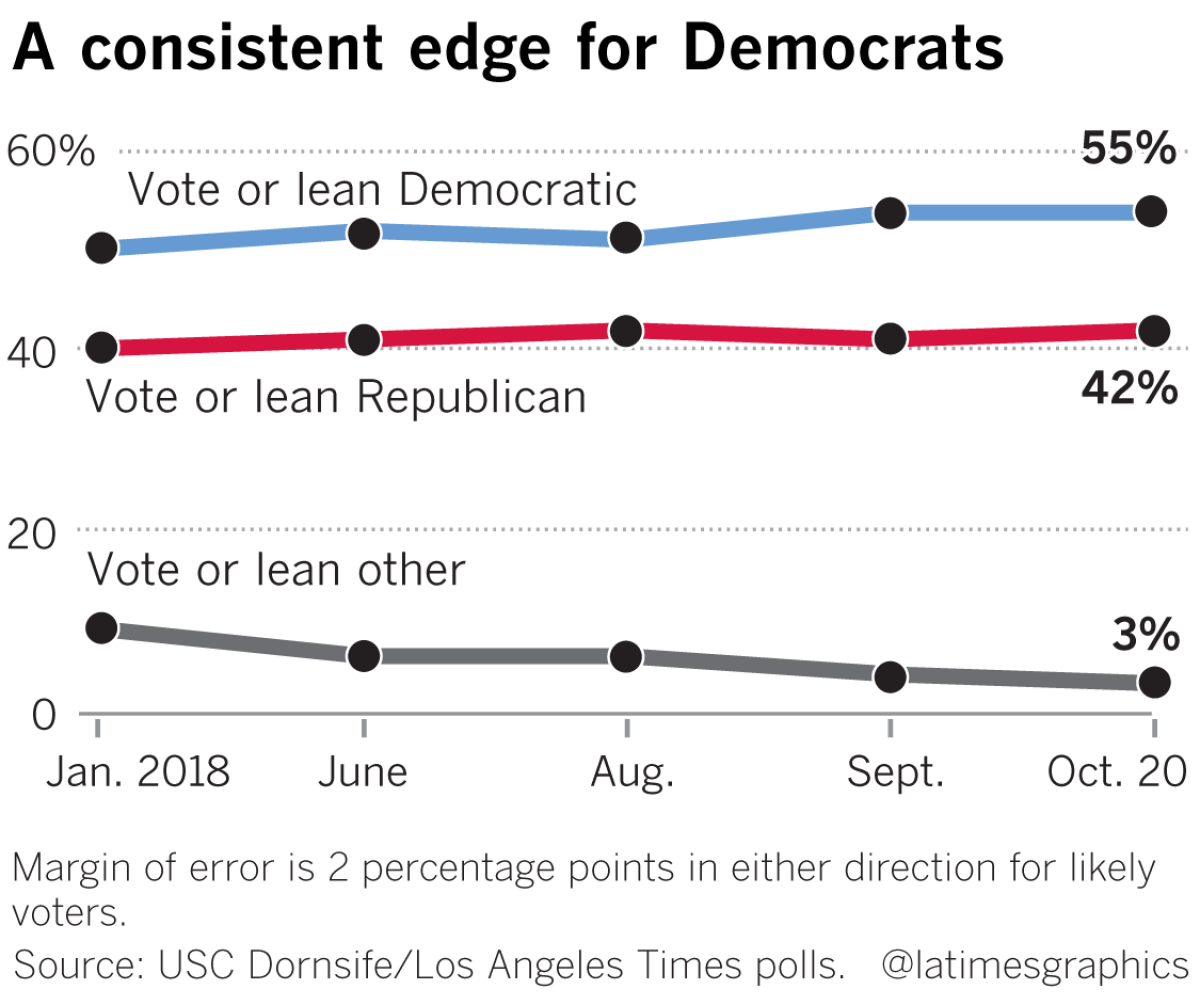With the midterm campaign in its final weeks, poll signals a Democratic edge for the House and widespread doubts about Kavanaugh

- Share via
Reporting from Washington — The last year has seen the enactment of a major tax cut, the first-ever summit between a U.S. president and the leader of North Korea, felony convictions and guilty pleas from two of the president’s former top aides and a bitterly fought battle over confirmation of a Supreme Court justice.
None fundamentally changed the overall race for control of Congress.
With the midterm now just over two weeks away, the election stands almost exactly as it did nine months ago, in mid-January: Democrats remain favored to win back a majority of the House, but haven’t decisively locked the contest down; Republicans remain favored to keep control of the Senate.
The uncanny stability, despite the year’s history-shaping headlines and furious controversies, testifies to the key political fact of our era: a deep and solidly entrenched partisan divide, made both wider and more intractable by the polarizing nature of the drama’s central figure, President Trump.
Trump “took over politics with his surprising victory in 2016 and now, two years in, the country is going to vote about him a second time,” said Mike Murphy, the longtime Republican strategist and critic of Trump who is the co-director of USC’s Center for the Political Future.
The challenge for Trump is that this time, he’s not matched up against Hillary Clinton. Instead, the election has been driven by two forces: Democrats’ deep anger toward Trump and what he stands for, coupled with the desire of a smaller, but crucial, bloc of swing voters to have Congress provide a check on a president whom many see as headstrong and risky.
The latest USC Dornsife/Los Angeles Times poll of voters nationwide shows Democrats with a 55%-42% lead when likely voters were asked which party’s candidate they would vote for in the Nov. 6 midterm election. The survey is the first of three weekly tracking polls of voter sentiment that USC and The Times plan to release between now and election day.

That 13-point Democratic advantage on the generic ballot — so called because it asks voters about party labels rather than specific candidates — is roughly similar to the findings of some other recent polls. An NBC/Wall Street Journal survey released Sunday, for example, showed Democrats with a 9-point advantage, 50% to 41%.
The desire to vote against Trump runs especially strong among female voters, particularly college-educated white women and minority women.
Their distaste for the administration — anger in many cases — has created political battlegrounds in suburban districts that once reliably voted for Republicans from Orange County to northern New Jersey. Democrats have a strong chance of winning enough of those districts to give them the additional 23 seats they need to have a majority in the House.
Just over half of the likely female voters in the USC/L.A. Times poll, 51%, said they saw their vote as an expression of opposition to Trump, compared with 24% who said it would express support for Trump and 25% who said neither. Men divided almost evenly on that question, with 38% in opposition, 36% in support and 26% saying neither.
Just over 6 in 10 white women with college degrees and a similar share of minority women said they saw their vote as an expression of opposition to Trump.
The shifting politics of healthcare have also boosted Democratic candidates, who have relentlessly reminded voters of the Republican effort last year to repeal Obamacare, especially its politically popular protections for people with preexisting health problems.
Republicans have tried to blunt that attack by professing their own desire to protect those with health problems, but their previous votes have hurt — a sharp reversal from the elections of 2010 and 2014 when Republicans rallied their voters by campaigning against the healthcare law.
But the Democrats haven’t won over some voters they had hoped to convince. A big part of what’s kept the Republicans afloat — and limited the potential Democratic gains — is the continued GOP majority among another group of women, whites without college degrees.
Only a third of those blue-collar white women said they saw their vote as expressing opposition to Trump. Four in 10 said they were voting in support of him, the poll found.
Related: See the results of the most recent USC/L.A. Times polls »
That support, coupled with the natural tendency of partisans to return to their corners as the election approaches, has improved Republican chances in conservative areas.
The impact can be seen in recent polls of key Senate races in Missouri, North Dakota and other states where Democratic incumbents are trying to hang on despite increasingly conservative electorates. The same dynamic has reduced Democratic hopes that their gains in the House could spread beyond the suburbs to more rural and blue-collar districts that Trump carried in 2016.
Democrats have, however, made gains across a crucial part of the country that played a big role in Trump’s upset victory that year, Midwestern and mid-Atlantic industrial states.
Democratic candidates for governor seem all but certain to win in Michigan and Illinois and have close races in Ohio and Wisconsin. Across the region, Trump-backed Republicans appear to be failing in efforts to unseat Democratic senators in Wisconsin, Michigan, Ohio and Pennsylvania — the four states that sealed the president’s victory.
In those areas, Democrats benefit from an extra dose of enthusiasm on the part of their voters. Nationwide, Democrats appear at least as eager to vote as Republicans and, by some measures, more so. That could erase a major turnout advantage Republicans held in the last two midterm elections.
In the poll, voters who said they were likely to cast ballots for Democrats were slightly more likely than Republican voters to say they were following the election closely. And the Democratic edge over Republicans on the generic ballot was the same among likely voters as among all registered voters — a switch from the pattern of recent years in which Republicans did better among those most likely to vote.
“It would be so unusual for a midterm election” if the party’s turnout equals that of Republicans, said Robert Shrum, the co-director of the USC Center for the Political Future. Achieving parity would be a major boost to Democratic chances, he said.
In the immediate aftermath of the hearings into now-Justice Brett M. Kavanaugh’s nomination to the Supreme Court, Republicans said the fight over the high court had energized their voters. Since then, polls around the country have given some indication of a boost in conservative areas, but also a post-Kavanaugh increase for Democrats in liberal precincts.
Overall, voters disapproved of Kavanaugh’s confirmation by 43% to 37%, the USC/L.A. Times poll found, with likely voters showing slightly more opposition, 50% to 37%.
Although women disapproved by a significantly larger margin than men, that difference more strongly reflects partisanship than gender, the poll found.
Women are more likely to be Democrats than are men. Factoring out that and other demographic data, party emerged as by far the biggest driver of people’s attitudes toward Kavanaugh, said Jill Darling, the survey’s director.
Most voters said the confirmation battle would not have an effect on whether they would vote — voters seldom say that any individual event will affect their ballot. The two parties were roughly equal in the share that said Kavanaugh’s confirmation would increase their likelihood of voting.
Asked whether they believed Kavanaugh could be fair and impartial as a member of the court, voters split evenly and, again, along sharply partisan lines. More than 9 in 10 Republicans said he would be impartial, while nearly 9 in 10 Democrats said no.
“That’s not a good result for the credibility of the court,” Shrum said. “Probably not since Bush v. Gore have you had people thinking this way,” he added, referring to the controversial decision in 2000 that ended the election recount in Florida, handing George W. Bush the presidency.
This USC Dornsife/Los Angeles Times poll was conducted Oct. 14 to 20 among 3,980 adult Americans, including 3,482 registered voters, of whom 2,284 were considered likely to vote. Respondents were drawn from a probability-based panel maintained by USC’s Center for Economic and Social Research for its Understanding America Study. Responses were weighted to accurately reflect known demographics of the U.S. population. The margin of error is 2 percentage points in either direction. A full description of the methodology, poll questions and data and additional information about the poll are posted on the USC website.
Get the latest news from the nation’s capital on Essential Washington >> »
For more on Politics and Policy, follow me @DavidLauter
More to Read
Get the L.A. Times Politics newsletter
Deeply reported insights into legislation, politics and policy from Sacramento, Washington and beyond. In your inbox three times per week.
You may occasionally receive promotional content from the Los Angeles Times.








